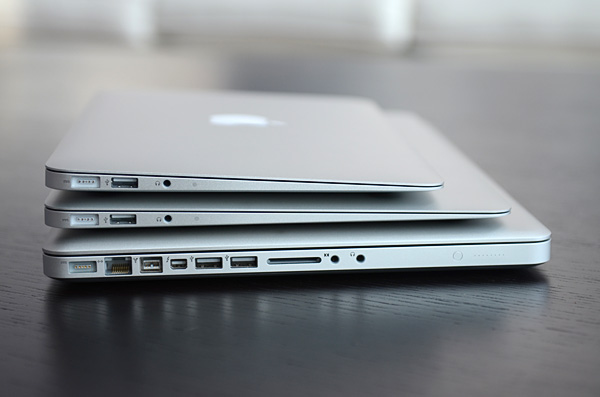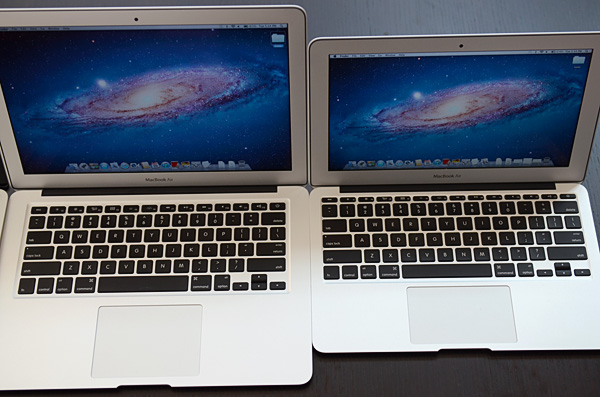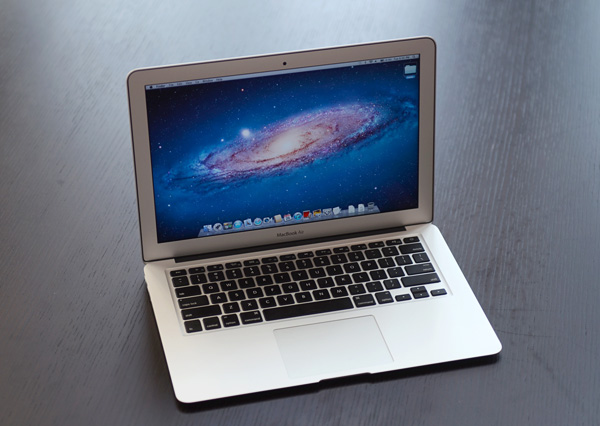The 2011 MacBook Air (11 & 13-inch): Thoroughly Reviewed
by Anand Lal Shimpi on July 28, 2011 3:25 AM EST- Posted in
- Apple
- Mac
- Intel
- Sandy Bridge
- MacBook Air
- Laptops
The 11
The 11-inch MacBook Air comes with a 1366 x 768 display (16:9) measuring 11.6-inches along the diagonal. Ports and features are near identical to last year's model. Up top there's a 640 x 480 camera. Along each side is a USB 2.0 port. Mag Safe and headphone jack are on the left, while Thunderbolt is on the right. There's a single fan inside the chassis that vents between the keyboard and the display hinge.
The 11 is still an amazing form factor. It's painless to carry around and you end up with a tablet sized device that makes no functional sacrifices. To make things even better, now you get a full blown Sandy Bridge CPU inside the ultra slim chassis.
There are really only two things that the 11-inch MacBook Air lacks. For starters, the lack of an integrated SD card reader means anyone looking to do photo work on the go will either need an Eye-Fi or an external USB card reader. Neither is too much of a pain however an integrated reader would be much appreciated.
The second issue with the 11 is its screen size/resolution. At 1366 x 768 you get great pixel pitch on the 11-inch 16:9 screen but there's just not a lot of vertical resolution on the display. The 13-inch model gives you only 5% more horizontal resolution but 17% more vertical, and that's noticeable.
Lion does alleviate some of this problem thanks to its full screen mode. Viewing Mail or Safari in full screen is almost necessary on the 11. Thanks to the 16:9 ratio of the panel, watching movies on the 11 is nearly equivalent to watching them on the 13-inch Air.
The base $999 configuration only comes with 2GB of DDR3 and a 64GB SSD. The latter is excusable if you just don't do much with your system (and technically it's something you can upgrade down the line if you'd like) but the former is a major problem. Memory on the MacBook Air is soldered directly onto the motherboard. Not having to build in a socket helps keep the z-height of the system down to a minimum, but it also severely limits flexibility. For most users interested in a dual-core machine under OS X I'd say that 4GB is probably good enough. While I'd prefer the option of upgrading to 8GB, I think 4GB is livable; 2GB is not. If you're considering the entry-level 11-inch MacBook Air I'd strongly recommend at least upgrading the memory to 4GB. The only exception is if you're just going to spend your time doing very basic tasks on the machine and plan on upgrading again in a year or two. If that's the case save your money and enjoy a 4GB version with Ivy Bridge next year. For everyone else, make sure you get the memory upgrade.
The 13
While the 11 is almost tablet-like, the 13-inch MacBook Air still looks and feels like a normal notebook. A really thin, really light notebook. You get a 1440 x 900 (16:10) display that measures 13.3-inches along the diagonal. The port layout is identical to the 11 although you get an integrated SD card reader along the right of the machine.

From top to bottom: 11-inch MacBook Air, 13-inch MacBook Air, 15-inch MacBook Pro
The 13 is really a pleasure to use, despite feeling a lot like a traditional notebook. The biggest difference for me between it and the 11 is the height of the display. Seated on a couch with the notebook in my lap the 13 doesn't force me to look down as much to see the screen. I still have to tilt my head down a bit, just not as much as with the 11.
The 13-inch screen maintains a relatively high pixel density, just shy of the 128 pixels per inch you get from the 15-inch MacBook Pro with the upgraded 1680 x 1050 display. I find the 13 is a bit easier to look at than the 11 with its 135 PPI display, but that's a personal preference. Apple really needs to increase the resolution of its 13-inch MacBook Pro which is a paltry 1280 x 800.

13-inch MacBook Air (left) vs. 11-inch MacBook Air (right)
The 13's base configuration is actually really good. You get 4GB of memory (neither Air supports more than 4GB of RAM) and a 1.7GHz Core i5. The 1.7GHz part here is a bit more interesting than the 1.6GHz chip in the 11 because it supports much higher max turbo frequencies (2.4/2.7GHz vs. 2.0/2.4GHz). If you don't need more than 128GB of internal storage, my recommendation would be to go for the base 13 at $1299.











103 Comments
View All Comments
netmask254 - Thursday, July 28, 2011 - link
It's really surprising to me that the huge random speed difference, and how can Apple tolerate such an inconsistent behavior among different machines? I heard that the buyer will randomly get a Sumsung or Toshiba SSD even for the same model, that's too bad. However, maybe most Apple users don't care about it or don't know it.beginner99 - Thursday, July 28, 2011 - link
Yeah, especially since you would actually pay an apple premium for knowing what you get. But then these are more priced like windows laptops so they probably had to lower some standards.The so called ultrabooks according to rumors might even be more expensive than MBA. IMHO especially the 256 GB version is a bargain (if you get the Samsung ssd). That alone costs you like 400$ if you would manually upgrade a cheap windows laptop.
Isn't the 4k random read the main thing that prevents stuttering issues ins ssd compared to hdds?
lyeoh - Thursday, July 28, 2011 - link
I think the stuttering is more to do with the max access latency.You could have a very fast drive that averages 100MB/sec over 1 minute, but if every 30 seconds it "hangs" for one second, you would notice it.
e.g. for one second your transfer rate drops to 0MB/sec, but for the other 29 seconds it transfers at 104MB/sec.
That's why many of those benchmarks don't tell you everything about how it feels.
Same goes for fps you could get 120fps but if what appears on the screen is actually delayed by a 100 milliseconds, it's worse than something that "only" does 60 fps with 5 millisecond delay.
Not many reviewers test for latency. Anandtech does have some latency tests for a few SSDs, but so far it does not appear to be a standard benchmark.
KPOM - Thursday, July 28, 2011 - link
Interestingly, on the MacRumors forum someone posted results of another benchmark that suggested that the Toshiba outperformed the Samsung on random reads and writes, though the Samsung outperform on sequential.http://translate.google.com/translate?u=http%3A%2F...
Anand says the Samsung outperforms on both. Note that this was also the case in the 2010s. Toshibas started shipping first, and Samsungs made their way into the system in January. Apple seems to have carried them over unchanged to the 2011. I wonder what impact supply chain issues (e.g. the tsunami) and legal issues (e.g. Apple's lawsuit against Samsung) have on their purchasing decisions?
fericia - Monday, August 15, 2011 - link
My wife's 13-inch one came with SM256...arthur449 - Thursday, July 28, 2011 - link
Light Web Browsing Battery Life13-inch MacBook Air (Mid 2011) - Core i5 2.7GHz
This message will self-destruct after reading.
Anand Lal Shimpi - Thursday, July 28, 2011 - link
Fixed :)Take care,
Anand
refresh_time - Thursday, July 28, 2011 - link
Thank you for a very in-depth review.I was ordered the i7 13" without needing the bigger ssd, but after reading this, I think i should exchange it for a i5 :D
All I wanted from i7 was video work on imovie but if there is only about a 10% gain in performance, I think I'm better with i5.. (right?)
But i read the mba review here (http://www.gadgetreview.com/2011/07/apple-macbook-... and they seem to recommend i7 highly. what do you think?
I'll use the return money to buy a 1tb hardrive and a nice sleeve
iwod - Thursday, July 28, 2011 - link
I think we need something thinner, lighter, and more size to choose from. Not everyone's home can fit a bloody 27" Monitor.ImSpartacus - Thursday, July 28, 2011 - link
Apple doesn't do low margin products.Even if they offered a 24" IPS panel with all the fixings, it would approach $500. It's hard to explain to a customer why they need to spend twice as much as a bargain bin 24" TN panel.
There aren't a lot of 1440p 27" monitors on the market today for less than $1000, so Apple doesn't run into any comparison problems. The camera, speakers and connectivity features are just gravy.